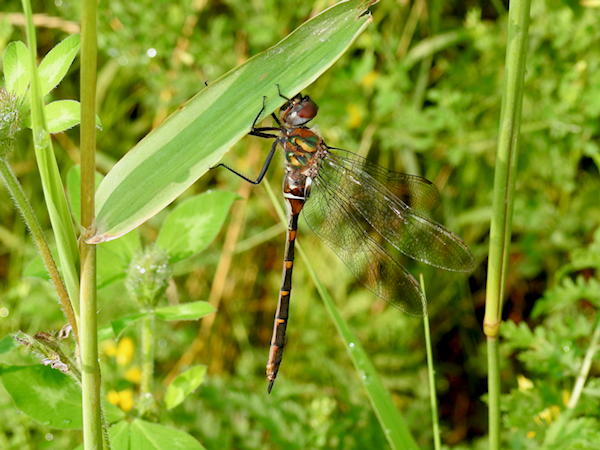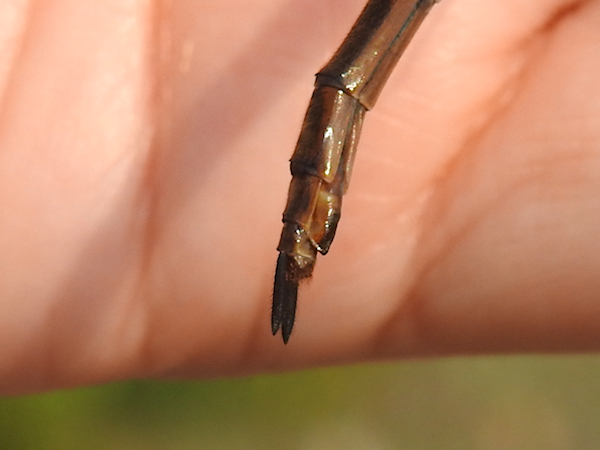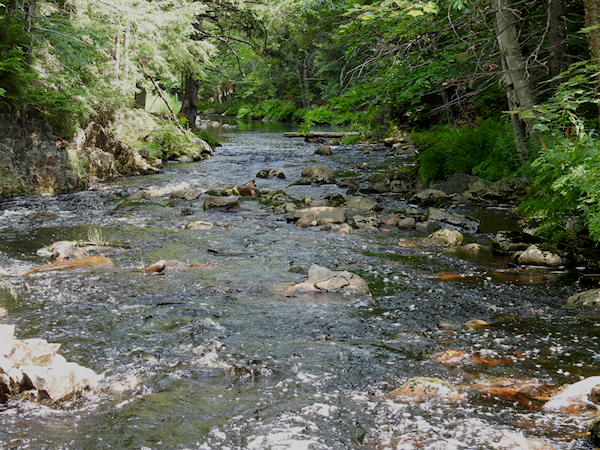
The morning of July 18th was warm and cloudless, so we resumed our search for rushing creeks, waterfalls, and odes. I had noticed one spot on Google maps that wasn’t too far from us – Slokum Brook Falls, just north of the Trans-Canada Highway. Photos showed a nice little brook with a steep waterfall in the middle of the woods, and reviews on Alltrails.com indicated that it was a bit difficult to find, as it is very overgrown at the beginning. It is said to be the highest falls on the North Mountain that drains into the valley, though there is really only water here during the spring runoff. We drove down Lily Lake Road, slowing down once we got past the lake itself. I peered into the dense foliage along the road, and found only two spots that looked like trails entering the woods, though both had “private property” signs at the entrance. Once the forest opened up we realized we must have gone past it, and decided to turn around at the end of the road, which elbowed north onto Douglas Road as the woods gave way to farm fields.
And that was when I saw them – several dark dragonflies cruising the wide open space of the intersection. The road was dry, dusty, and completely devoid of traffic so I asked Doran to pull over to the side of the road so I could get out. When I did I noticed about a dozen dragonflies flying over the road, the ditches at the side of the road, and a decent-sized planting of shrubs next to the ditch. There were emeralds mixed in with gliders….I recognized these carrot-shaped skimmers and thought they were probably all Spot-winged Gliders as they didn’t seem golden enough for Wandering Gliders. I readied myself with the net, and after a few minutes of waiting caught my first dragonfly. I was thrilled to see it was indeed an emerald, then a little disappointed when I realized I actually recognized the hairy, upturned claspers and the two dissimilar yellow spots on the thorax:

I caught four Brush-tipped Emeralds about a month ago in Marlborough Forest, so this was definitely not a stranger. However, I was hoping for something a little more unusual, perhaps something new. I admired its bronze and green colours for a moment, then let it go.
After that I simply watched the dragonflies patrolling the intersection, getting a feel for how many species might be present. There were probably three Spot-winged Gliders, though they never did get close enough to see the “spots” on the hindwings, and emeralds of two different sizes: the tiny Brush-tipped and some larger ones. It was the larger ones I was interested in, and I spent some more time trying to get into position to catch one. They seemed to like the ditch inside the elbow-corner of the intersection, so I waited there for a few moments; then they all seemed to find the air above the group of shrubs on the other side of the road much more to their liking. It took me a little longer on my second attempt, but then I heard the unmistakable sound of a dragonfly’s wings beating angrily inside the net. When I pulled it out of the net I was thrilled to see it was indeed a larger emerald, but beyond that I wasn’t sure what it was.

I took several photos of it from different angles, then placed it on a plant to try to get a more natural-looking image. For some reason emeralds don’t open or close their wings nicely, or hang straight when placed on a twig or leaf when placed there by a human hand; I just don’t know what it is about this group, but getting a nice print-worthy image of one caught and then posed is difficult! They are much more symmetrical when they land in the vegetation on their own, but they either never land or land so high up that photography is impossible!

Once we got back to our Airbnb in Middleton I began pouring over my books. I had caught a female, which made identification a bit trickier. Her sub-genital plate pointed backward, like a Brush-tipped Emerald’s, and the yellow markings on the thorax had similar proportions to those of a Brush-tipped Emerald: a long stripe in front of a smaller, rounded spot. The only one that matched that description was the Incurvate Emerald (Somatochlora incurvata): Delicate and Kennedy’s Emerald only have one yellow spot on the thorax, and Forcipate Emerald has two equal-sized round spots on the thorax. It was a lifer for me!

The thing that puzzled me was its location: a dusty country road in a swarm of other dragonflies. (I wondered what other emerald species might have been flying with that swarm; too bad we couldn’t have stayed longer to find out!) According to my field guide and various online sources, Incurvate Emeralds inhabit small pools in fens and sphagnum bogs as well as open sedge meadows. Then I found an excellent article in The Boghaunter, a newsletter which contains “Occasional News About the Dragonflies and Damselflies of Vermont”, which every ode enthusiast in the northeast or in love with the emerald family should read: Courting Corduliidae: On securing Somatochlora and navigating Neurocordulia, written by the late Paul M. Brunelle.1 He notes that the Incurvate Emerald is one of the most common dragonflies in August in its bog habitat in Maine and the Maritime provinces, often found foraging over roads or on the road as victims of vehicle collisions. It has a very long flight period, from late June to mid-October, and often chases away smaller emeralds such as the Delicate Emerald (Somatochlora franklini). For finding emeralds in general, he gives the following advice: “Look for woods road aligned about east to west. You can see the little devils a mile off in the early evening (also on bogs). Intersections of woods roads are excellent places, as both the sun-loving and shade-loving species end up there at one point or the other”.

And where was this swarm found? On a forested road running east-west, right where it intersected an open country road. Paul-Michael Brunelle was not only a witty writer, he was an odonatological genius. He surveyed much of Nova Scotia and even and discovered a new species, the Broad-tailed Shadowdragon (Neurocordulia michaeli) in 1995, which he described in the scientific literature and named for his son in 2000. I had hopes of communicating with him about the odes of Nova Scotia and was devastated to learn he had passed away only a few years ago.
With our plans to explore Slokum Brook Falls scuppered, we returned to home base, then figured out a new plan: check out the Upper Black River Falls along Allen Lake Road near Bloomington. It was supposed to be a short walk from the road; an unofficial trail started just before bridge on the left-hand side of the road. We decided to take some back roads to the area: Google has us driving to Inglisville on Crisp Road, then taking the Inglisville Road through East Inglisville to Neily Road South. It looked good on paper (well, my laptop screen anyway), but once we reached East Inglisville the road ended in a small clearing and continued as something smaller than a deer track that disappeared into the bush in front of us. I was rather incensed with Google’s definition of “road”, since it looked like the deer track proceeded through private property. Then I realized there was a small swarm of dragonflies flying over the waist-high vegetation edging the clearing. My mood improved rapidly, and I grabbed my net and tried to catch a few. My first catch was a dragonfly I’d hoped to see up close, the Petite Emerald! It was another immature female, with brown eyes instead of green.

A few larger emeralds were flying over the road (once again, aligned east-west with only a few rural houses and farms in between large stretches of forest) and one flew tantalizingly close before landing on a large green leaf. I got a good enough look at it to see the male claspers of a male Clamp-tipped Emerald; no other species has the small ring-shaped claspers at the tip of the abdomen. I brought my camera up to take a picture, and then he flew off, never to be seen again. I should have caught him instead, but I was enthralled with the idea of getting a photo of one perching naturally.
Doran was getting uneasy as the farmhouse right before the dead-end had two large, barking dogs running loose so I reluctantly got in the car. We had to backtrack in order to find our way to the Upper Black River Falls, then when we found the location we drove over the bridge, past the trail, and had to turn around again. The road was a sunny one cutting through the forest with trees growing high on both sides, and I spotted another large dragonfly patrolling the trail. Once again we stopped, and I caught it easily; it turned out to be a darner rather than an emerald.

This was the first mosaic darner of the trip, and the thoracic stripes and the completely black final segment confirmed its identity as a Black-tipped Darner, a new species for my Nova Scotia list.

There were a few more dragonflies patrolling the area over the bridge, a small structure with small guardrails. I made a mental note to try to catch them on the way back, turning my attention instead to the small damselflies soaking in the heat from the wooden boards. They were Violet Dancers, one of the prettiest damselflies in my opinion!

We made our way along the trail and found the falls only a couple hundred meters in. Like the Nictaux Falls they weren’t particularly high. The river was flowing rapidly down the channel, but there were a few rocks exposed. I didn’t see anything resting on them, much to my disappointment, and I grew excited when I spotted a medium-sized dragonfly zip over the falls and fly up into the tree canopy. It never came back or flew low enough to identify it, but I was happy enough to see that there was at least one dragonfly around.

There were, of course, Ebony Jewelwings perching in the vegetation along the stream. What shaded creek in the northeast doesn’t have these glittering velvety black-winged damselflies dancing over the rushing water?

As we walked along the bank I finally noticed one rock that did have a dragonfly sitting on top. It was a clubtail of some sort, but didn’t seem particularly large. Then I noticed the white claspers – it was a male Eastern Least Clubtail! How strange that I’d never seen a mature adult of this species at all until this year, and now I’d seen one in two different provinces! It spent quite some time on that rock, sallying out every now and then after insects too small for me to see.

We walked along the trail for a bit – then, as it was hot, took our shoes off and waded in the water. It felt refreshingly cold. We would have liked to have walked along the river on the other side of the bridge, but there was no walking path there. Once we were done exploring we headed back to the car and I looked for the large dragonflies I had seen patrolling above the bridge. They were, of course, gone. However, I did see something interesting in the magenta thistle flowers growing alongside the road. A small clearwing moth was hovering over the blossom, sipping nectar through its long proboscis. I took a few photos and the yellow legs suggested it was a Hummingbird Clearwing Moth, a variable species which resembles a number of similar-looking clearwing species. The light-colored legs, together with the lack of striping on the underside is diagnostic for this species. Because of its size and its habit of visiting flowers during the day it is often mistaken for a bee or a hummingbird.

That was the last really good weather we had for hitting the back roads and checking out Nova Scotia’s waterfalls. We tried to fit in one more excursion before the end of the trip and ended up taking a road – Johnson’s Pond Road – that looked on Google maps like a typical rural forest road crossing over some promising streams and marshy areas, but which in reality got narrower and narrower until you couldn’t open the car door without hitting the vegetation. It was also badly rutted with large potholes and puddles and slabs of rock integrated into the dirt road…good thing we had our Jeep! The bad road combined with the thick bank of clouds overhead and wisps of fog settled in the hollows made it for a frustrating excursion, and we ended up turning around without anything to show for the it. I did see a few more dragonflies cruising along the road, but each time we stopped I was quickly swallowed up by a cloud of mosquitoes and the dragonflies that did circle back to feast on them evaded my net.
Altogether I was thrilled to get one lifer and two new Nova Scotia dragonflies on these outings. I would have liked to have found some other stream-loving dragonflies (such as the snaketails) and road-cruising emeralds, but they would have to wait for another time. Conditions must have been just right on July 18 because when we revisited the intersection of Douglas Road Lily Lake Road on the next sunny day the dragonfly swarm was gone. One thing you can depend on in nature: no two days are exactly alike!
- Brunelle, Paul M. Courting Corduliidae: On securing Somatochlora and navigating Neurocordulia.
The Boghaunter No. 9.[Internet]. Spring 2007 [cited 2024 May 22]. Available from: https://val.vtecostudies.org/wp-content/uploads/2017/04/Boghaunter-No.-9-Finding-Somatochlora.pdf ↩︎